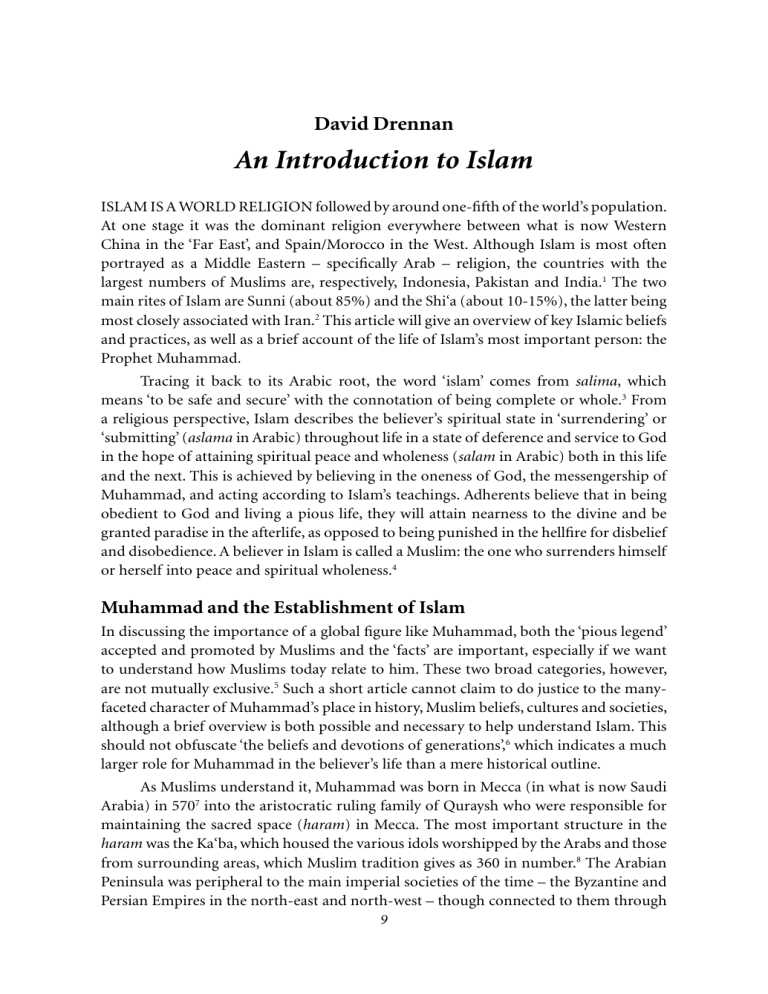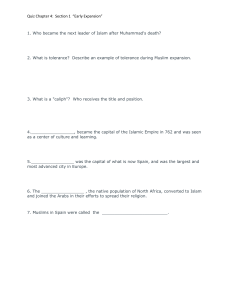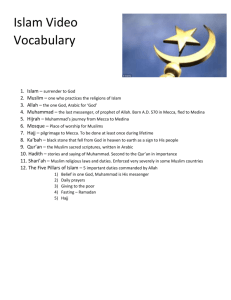
David Drennan An Introduction to Islam ISLAM IS A WORLD RELIGION followed by around one-fifth of the world’s population. At one stage it was the dominant religion everywhere between what is now Western China in the ‘Far East’, and Spain/Morocco in the West. Although Islam is most often portrayed as a Middle Eastern – specifically Arab – religion, the countries with the largest numbers of Muslims are, respectively, Indonesia, Pakistan and India.1 The two main rites of Islam are Sunni (about 85%) and the Shi‘a (about 10-15%), the latter being most closely associated with Iran.2 This article will give an overview of key Islamic beliefs and practices, as well as a brief account of the life of Islam’s most important person: the Prophet Muhammad. Tracing it back to its Arabic root, the word ‘islam’ comes from salima, which means ‘to be safe and secure’ with the connotation of being complete or whole.3 From a religious perspective, Islam describes the believer’s spiritual state in ‘surrendering’ or ‘submitting’ (aslama in Arabic) throughout life in a state of deference and service to God in the hope of attaining spiritual peace and wholeness (salam in Arabic) both in this life and the next. This is achieved by believing in the oneness of God, the messengership of Muhammad, and acting according to Islam’s teachings. Adherents believe that in being obedient to God and living a pious life, they will attain nearness to the divine and be granted paradise in the afterlife, as opposed to being punished in the hellfire for disbelief and disobedience. A believer in Islam is called a Muslim: the one who surrenders himself or herself into peace and spiritual wholeness.4 Muhammad and the Establishment of Islam In discussing the importance of a global figure like Muhammad, both the ‘pious legend’ accepted and promoted by Muslims and the ‘facts’ are important, especially if we want to understand how Muslims today relate to him. These two broad categories, however, are not mutually exclusive.5 Such a short article cannot claim to do justice to the manyfaceted character of Muhammad’s place in history, Muslim beliefs, cultures and societies, although a brief overview is both possible and necessary to help understand Islam. This should not obfuscate ‘the beliefs and devotions of generations’,6 which indicates a much larger role for Muhammad in the believer’s life than a mere historical outline. As Muslims understand it, Muhammad was born in Mecca (in what is now Saudi Arabia) in 5707 into the aristocratic ruling family of Quraysh who were responsible for maintaining the sacred space (haram) in Mecca. The most important structure in the haram was the Ka‘ba, which housed the various idols worshipped by the Arabs and those from surrounding areas, which Muslim tradition gives as 360 in number.8 The Arabian Peninsula was peripheral to the main imperial societies of the time – the Byzantine and Persian Empires in the north-east and north-west – though connected to them through 9 The La Trobe Journal established trade routes. Connection through trade was also made with the Kingdom of Axum in Ethiopia and Yemen to the south.9 Judaism and Christianity were present in Arabia, although the majority of Arabs at that time were polytheists of various types. There was also a small group known as the hunafa’ who rejected polytheism, believing in monotheism and the God of Abraham. These various and somewhat competing religious influences highlight the connection between Arabia, Arabian religion and the various aspects of religious and political ferment in the Near East at that time.10 Growing into adulthood, Muhammad engaged in a number of occupations including shepherding and trading. Employed by the wealthy and esteemed Khadija, he accepted her offer of marriage when he was twenty-five and she, reportedly fifteen years his senior; he remained devoted to her throughout his life until her death. The beginning of his prophetic mission did not occur until he was forty years old, in 610. Over the years, Muhammad would retreat to the mountain of Hira’ in order to meditate and contemplate, free from the stresses of city life; at that time Mecca was a major trade centre and also a place of religious pilgrimage. It was during one such retreat that the archangel Gabriel appeared and ordered Muhammad to ‘Read!’ to which he replied, ‘I am not of those who read’ (meaning, he was illiterate). The order was repeated and Muhammad replied once again that he could not. Gabriel then repeated the request, this time with a subtle difference indicating Muhammad’s messengership. This encounter gave rise to the first five divinely-revealed verses of the Qur’an: Islam’s scripture. Translated from Arabic, these are: 1 Read! In the name of your Lord who created. 2 He created man from a clinging form. 3 Read! And your Lord is the Most Bountiful One. 4 who taught [by means of] the pen. 5 who taught man what he did not know [Qur’an 96:1-5].11 Muhammad was overcome by terror at the event and took shelter with Khadija who affirmed her faith in him and his experience. Thus, Muhammad’s wife, his younger cousin ‘Ali b. Abi Talib, and his close friend Abu Bakr became the first to affirm their faith in Islam.12 At first regarded as an eccentricity by the Quraysh and visiting pilgrims alike, over time Muhammad’s preaching of strict monotheism became a major threat to the Meccan elite’s main source of power and revenue: the pilgrimage and its associated idolatry.13 The Meccan rulers ordered a boycott of Muhammad’s tribe (the Banu Hashim, a sub-branch of the Quraysh), resulting in severe adversity and famine for Muhammad, his followers and his own tribe, many of whom were not Muslim at that time. The boycott no doubt contributed to the deaths of both Muhammad’s uncle and protector, Abu Talib (who remained a non-Muslim), and Khadija.14 The persecution and oppression faced by the fledgling Muslim community became more intense after this, resulting in Muhammad sending a number of Muslims to safety in the Ethiopian empire ruled by the Negus, a Christian King who accepted the Muslim 10 An Introduction to Islam refugees warmly. Shortly after, in 622, the remainder of the Muslims in Mecca migrated to Yathrib which became known as Madinat al-Nabi, ‘the city of the prophet’. Today, simply known as Medina, it is the second holiest site for Muslims, after Mecca. This migration, known as the hijra in Arabic was so pivotal in Islamic history that it marks the beginning of the Muslim lunar calendar. After establishing the fledgling religious community in Medina, through a process of partnering Meccan migrants (the Muhajirun) with local helpers (the Ansar), open hostility developed between the Medinan city-state and the Quraysh in Mecca. This state of antagonism lasted for almost ten years, resulting in a number of raids and battles. In at least one instance, it looked as if Medina itself would fall due to the overwhelming numbers of the opposing Meccan force assisted by local allies who had treacherously swapped allegiances. Eventually, however, Muhammad and the Muslims returned to Mecca to make their own pilgrimage to the Ka‘ba, which they believed was established by Abraham and Ishmael as a house of monotheistic worship, and only later corrupted by polytheistic practices. The first time they appeared outside Mecca they were refused entry but concluded a pact with the Meccans known as the Treaty of Hudaybiyya, promising them permission to perform their pilgrimage the following year. The treaty brokered an uneasy peace between the Quraysh and the Muslims, which was later broken by an allied tribe of the Quraysh, reigniting hostilities.15 Muhammad and the Muslims soon returned to Mecca. The Quraysh finally accepted that Islam had become the major religious and social force in Asia and the Muslims established their rule there almost entirely without bloodshed. Muhammad died a few short years later in 632, sparking a crisis of leadership within the Muslim community, temporarily resolved with Muhammad’s close friend Abu Bakr being accepted as leader by both the Muhajirun and Ansar. Abu Bakr’s rule inaugurated a series of leaders known to the Sunnis as the ‘Rightly Guided Caliphs’ – they were Abu Bakr, ‘Umar b. al-Khattab, ‘Uthman b. ‘Affan and lastly Muhummad’s cousin and son-in-law, ‘Ali b. Abi Talib. Disagreements over the leadership issue led to the ultimate divergence between the Sunni and Shi‘i strands of Islam, resting on the status of ‘Ali and his progeny from his marriage with Muhammad’s daughter Fatima. For Shi‘i Muslims, Muhammad’s divinely appointed and rightful successor was ‘Ali and then his and Fatima’s descendants. However, important opponents questioned a number of ‘Ali’s political decisions and the Muslim community began to irretrievably fracture. This eventually resulted in ‘Ali’s murder; the quietism of ‘Ali and Fatima’s older son Hasan; and the martyrdom of their younger son Husayn. It is this last event that marks the main historical fissure between Sunnis and the Shi‘a. Over time, this divergence took on doctrinal as well as political characteristics.16 Islam spread outside of Arabia both during and after this period with a number of successive dynasties ruling the Muslim world until the coming of the colonial era in the nineteenth century. There is not space in the present article to elaborate fully – covering 11 The La Trobe Journal A very early English edition of the Koran, translated from the French and published in 1649. Rare Books Collection. over a millennium and a quarter of history – so the remainder of this article discusses the foundational beliefs and practices of Islam.17 The Primary Sources of Islamic Beliefs and Practices The Qur’an The Qur’an (sometimes spelled Koran in English) is the central Islamic source scripture. The Qur’an has been preserved as a written text but its original and primary form is as an oral transmission; the Arabic term qur’an itself means ‘recitation’. Its importance in the daily life of believing Muslims cannot be over-estimated.18 The Qur’an was revealed in piecemeal fashion over a period of 23 years and was preserved and arranged into the structure we have today, according to Muslim tradition, both during the lifetime of Muhammad and after his death. It is a non-linear text arranged neither in chronological nor topical order. There are 114 chapters (surat, sing. sura) which vary widely in length, with around 6,200 verses (ayat sing. aya) in total. The shortest chapter has only three verses, whilst the longest has 286.19 Because of its non-linearity, the Muslims developed a 12 An Introduction to Islam Another early English edition of the Koran, this one translated from the original Arabic and published in 1734. Rare Books Collection. religious science devoted to understanding the ‘occasions of revelation’ (asbab al-nuzul): establishing verse dating and context. The Qur’anic message deals both with the various historical incidents that occurred during the life and mission of the Messenger, as well as various universal theological and moral themes. Sections of the Qur’an discuss a variety of topics such the assertion of absolute monotheism, for example, or familiar Abrahamic motifs such as the day of judgement; heaven and hell; and previous messengers and prophets and their followers. Other sections go into detail regarding more seemingly mundane matters such as the process of trade and business; marriage contracts; and bequests. The Qur’an is the foundation for many of the Islamic and even non-religious disciplines that sprung up in the Islamicate civilisations. Exegesis and the art of recitation are perhaps the two most immediately connected to the text, but besides this, the morphology, syntax and grammar of the Arabic language itself was codified using the Qur’an and pre-Islamic Arabic poetry as a base. Calligraphic representation of Qur’anic verses and motifs is perhaps the quintessential art form throughout Islamic history.20 13 The La Trobe Journal ‘The Hour of Prayer’ [Muslims praying on board immigrant ship]. Illustrated Australian News, 26 November 1884. The Prophetic Example (Sunna) The sunna, or prophetic example, is not considered scripture per se, yet it has been codified through collections of oral narrations about the Messenger’s life, personality and teachings (in texts known as hadith sing. ahadith) and is considered the second most authoritative religious source to the Qur’an. The sunna is defined as whatever Muhammad did, said or tacitly approved of in others.21 A narrated hadith is made up of two components: the chain of transmission (isnad) and the content itself (matn). Some narrations are direct sayings of Muhammad, whilst others denote actions either accepted or prohibited by him for his followers.22 In order to sift authentically narrated material from that which was forged or inaccurate, Muslim scholars developed an intricate method of analysing the chains of transmission in order to garner their provenance. The hadith scholars then categorised the narrations into various grades, including authentic (sahih), fair/good (hasan), weak (da‘if) or fabricated (mawdu‘).23 The level of authenticity, scope of transmission and the tradition’s wording affects its use as a source of exegesis or legal precedent.24 Six hadith collections are considered authoritative in Sunni Islam, the main two of these being the Sahih al-Bukhari of Muhammad b. Isma‘il al-Bukhari (d. 870), and 14 An Introduction to Islam the Sahih Muslim, of Muslim b. al-Hajjaj (d. 875). For Shi‘i Muslims, the collections of al-Kaylani (d. 941), Ibn Babawayh (d. 991) and al-Tusi (d. 1067) are considered authoritative.25 The hadith and sunna play an important role in believing Muslims’ lives as they are second only to the Qur’an in terms of religious authority.26 The Five Pillars of Islamic Practice There are five religious observances that every practising adult Muslim – both male and female – are obliged to perform. These are commonly known as the ‘five pillars’.27 The first ‘pillar’ is bearing witness (shahada). This consists of speaking a twosentence creedal formula that denotes belief in the unicity of God, and the messengership of Muhammad. The shahada is recited upon conversion to Islam and multiple times during daily prayers as well as in regular supplications (du ‘a’) and invocations (dhikr). It is also the phrase that pious Muslims hope will be their last before they die. The second ‘pillar’ is prayer (salat). Practising Muslims observe five daily obligatory prayers, performed facing the direction of the Ka‘ba in Mecca. They are connected to the progression of time throughout the day with timings as follows: at dawn; just after the sun reaches its zenith around lunchtime; mid-afternoon; just after sunset; and finally at night-time. Each prayer consists of numerous cycles of standing, bowing from the waist and prostrating, all performed after completing ritual ablutions with water. Each stage includes the recitation of numerous litanies and supplications including sections from the Qur’an entirely in Arabic. The opening chapter of the Qur’an is recited in every prayer cycle, and means in English: 1 2 3 4 5 6 7 In the name of God, the Lord of Mercy, the Giver of Mercy! Praise belongs to God, Lord of the Worlds, the Lord of Mercy, the Giver of Mercy, Master of the Day of Judgement. It is You we worship; it is You we ask for help. Guide us to the straight path: the path of those You have blessed, those who incur no anger and who have not gone astray [Qur’an 1:1-7]. On Fridays, a special congregational prayer is conducted instead of the midday prayer, where the prayer leader (imam) also delivers a sermon. Aside from the highly ritualised salat, personal prayers and supplications are encouraged and are said in any language and at any time. The third ‘pillar’ is the purification of wealth (zakat) with its name taken from the Arabic word zaka meaning both ‘to purify’ and also ‘to increase’.28 That is, a percentage (usually 2.5%) of a Muslim’s lawfully-accumulated wealth held over a year is donated in charity. There is a complex method of calculating zakat but the basic idea is that if an adult Muslim makes over a minimum threshold, then they are liable to pay it. If, on the other hand they make below this, then they are eligible to receive it. Giving charity (sadaqa) outside of zakat is also considered highly meritorious. 15 The La Trobe Journal The fourth ‘pillar’ is fasting (sawm), and concerns fasting during the lunar month of Ramadan each year. The Islamic lunar calendar has months of either 29 or 30 days, depending on the cycle of the moon. During Ramadan every adult and able-bodied Muslim is required to abstain from food, drink and sexual intercourse from before dawn until sunset. Those unable to fast whether due to old age, travel, menstruation, pregnancy, or because they suffer with a medical condition that fasting would worsen, are not required to fast. Instead, they variously make up the fast at another time and/or donate to charity instead. Muslims are encouraged, particularly during Ramadan, to focus on increasing their worship; giving to charity; increase reciting and reading the Qur’an; and to improve their moral character particularly. Ramadan is a family and community-oriented affair, with families often eating special dishes together, which are made only at this time of year. Extra communal prayers are held during Ramadan after the night-time prayer. The final ‘pillar’ is the pilgrimage (hajj) to Mecca. It is to be performed at least once in their life by each adult and financially unencumbered Muslim. The rites of the hajj include circumambulation of the Ka‘ba itself; recreating the movements of Hagar and Ishmael; throwing stones at pillars representing Satan; and standing on the plains of ‘Arafat seeking forgiveness for sins. According to Muslim tradition, if the pilgrimage is accepted by God all of a Muslim’s previous sins are forgiven, so it is considered an important and life-changing event. Although the five ‘pillars’ are obligatory, obviously Muslims vary in the extent to which they observe them. Muslims, like everyone else, come in a wide variety of approaches to religious belief and practice. So long as a believer has uttered the first pillar at least once in their lifetime (without recanting), they are considered Muslim. There exists no real authority that can excommunicate a Muslim for sinfulness and failure to practice Islam, although excommunication through accusations of apostasy has been used as a political tool by leaders at various times in Muslim history. Islamic Creedal Beliefs As mentioned previously, the Qur’an is the foundation of Islamic beliefs and practices. The absolute oneness of God is the pre-eminent focus of Islamic theology. Like Judaism, Islam is strictly monotheistic, asserting that God is the ultimate reality and creator of all things, having attributes and characteristics that completely negate any type of polytheism. God is ever living, and cognisant of all creation including human beings’ motivations, thoughts and actions. God has ultimate power and dominion over all things, requiring neither rest nor sleep. Belief in both angels and the ‘unseen’ realm (al-ghayb) are also central to Islam. Ultimately, there is more to life than that experienced through sense perception or intellect alone, and for Muslims, as well as the other Abrahamic faiths, this includes angels. Some are given specific names and functions, including the archangel Gabriel who is responsible for heralding revelation and conveying God’s message to the prophets 16 An Introduction to Islam and messengers. Mention is made also of Michael, Raphael, and the angel of death (malak al-mawt), all having their own responsibilities. In addition, there is also a class of beings in the unseen realm called jinn (from which ‘genie’ comes) who can be Muslim or followers of Satan, the personification of evil. The third aspect of faith is belief in previously revealed scriptures. Muslims believe that revelation from God has occurred since the creation of humankind, fulfilling a divine covenant made between God and the children of Adam.29 That being the case, a number of previously-revealed scriptures are mentioned by name in the Qur’an and hadith, of which the most widely known are those given to Abraham and Moses (the suhuf and the tawrat), to David (the zabur), and to Jesus (the injil). Muhammad was given the Qur’an, the final scriptural revelation, applicable for the rest of time, according to Muslims. Nevertheless, holy books as they currently stand with older religious groups (e.g. the Biblical texts) are not accepted as infallible and divine in their entirety. Rather, the Qur’an is considered the criterion by which to accept or reject the contents of other groups’ teachings. The next element of faith is belief in God’s messengers and prophets. Muslims believe that bearers of God’s revelation have been among humankind since the very beginning. Due to human nature’s inherent forgetfulness and neglect of the divine reality, becoming distracted by and preoccupied with worldly life, humankind therefore needs constant reminding of God’s unity and transcendence, and that all will ultimately be held accountable after death for their beliefs and actions. Twenty-five messengers and prophets are specifically mentioned by name in the Qur’an, the majority of them recognisable as Biblical figures, but a hadith tradition mentions the number of prophets sent to humanity as 124,000, culminating with Muhammad: ‘Muhammad is not the father of any one of your men; he is God’s Messenger and the seal of the prophets: God knows everything’ [Qur’an 33:40]. The penultimate point of creedal belief is the afterlife, and in particular, judgement day. Like the other two Abrahamic faiths, Muslims believe in both life-after-death and also judgement day, when at some unknown point in the future, the ‘trumpet’ will be blown signalling the end-times. Every human being will be resurrected and held accountable for their deeds in life. Each person will then be rewarded or punished, according to God’s divine judgement and mercy, being placed either into paradise or hell, occupying varying degrees of felicity or punishment. The last creedal point is belief in divine decree, or God’s all-encompassing omniscience covering everything that has been, is, and will be. This is known as qadar in Arabic, a term which connotes various meanings such as measure, power, determination, capacity and ability. ‘To measure something, in this sense, is to control it and govern it, to have power over it.’30 Because of the Muslim belief that ‘God has power over everything’ [Qur’an 3:189], including the minute details of all existence, Muslims believe that he has ‘measured out’ both the good and evil, happy and sad found in the world, both in terms of our own experiences, and also in a spiritual sense. ‘A true believer must recognize the 17 The La Trobe Journal impossibility for each one of us to determine what will happen in the grand scheme of things.’31 Qadar should not be taken as fatalism; the debate over free will versus predestination is well-known in Islamic history, leading to the development of a number of early theological schisms amongst the Muslims.32 The view that came to dominate Sunni Islam is that human beings may think of doing or want to do certain things, but it is only through God allowing the action to take place that it actually occurs, with human accountability for it on Judgement Day. Having surveyed the foundational Islamic beliefs and practices, the remainder of this article will discuss two important concepts in Islam: Islamic law (shari‘a) and spirituality (Sufism). Islamic Law (Shari‘a) Coming from an ancient Arabic root word meaning ‘a way to the watering-place’, shari‘a has become a catch-all term used to designate the entirety of the Islamic legal and juristic tradition by both Muslims and non-Muslims alike.33 Essentially, this legal tradition is concerned with indicating the correct way for human beings to act according to the divine will, in order that they might achieve felicity. Until the mid-nineteenth century and the onset of colonialism, Muslim polities had various institutional and administrative structures in place in order to support law and order amongst their populations. This included courts, judges, and marketplace inspectors, all of whom were part of the apparatus used to enforce law. There were also private legal experts, school teachers and entire school curricula dedicated to producing functioning judges and legal experts, all largely independent of state interference.34 The only difference between this and other legal systems is that the law was, and is, based upon interpretations of the Qur’an and sunna: revealing the divine will as Muslims understand it. This deriving of law from scriptural sources is similar to Jewish halacha law, and Catholic canon law, for example, rather than the enforcement of legal codes established by committees and state officials. The role of human agency in interpreting and producing sacred law (whether Jewish, Christian or Islamic) cannot, however, be overstated.35 Shari‘a contains not only societal legal proscriptions enforced by mechanisms of governance, but also a vast moral framework to which legally-responsible believing adults submit themselves in order to gain divine pleasure and avoid divine censure. All acts fall into one of five categories: obligatory, recommended, neutral, disapproved, and forbidden, with only the first and last of these being considered law proper, the others being considered meritorious or detestable in terms of spiritual excellence.36 Outside of devotional practices (the realm of ‘ibadat), the vast majority of shari‘a interpretations and rulings are concerned with commercial and societal laws (the realm of mu‘amalat). These primarily deal with business and trade – contracts, buying and 18 An Introduction to Islam selling, etc. – plus property rights, inheritance, marriage and divorce. Then there is also criminal law, that relating to evidentiary procedure, personal injury and the like.37 Apart from the Qur’an and sunna – the two primary sources of law – the main methods for deriving new legal rulings are known as juristic consensus (ijma‘) and analogical reasoning (qiyas), both rational in nature. Other legal methods used include: local custom as a source of law; applying extracted legal maxims and principles to derive new rulings; and basing each law upon establishing public interest. Over the centuries, different schools of legal interpretation arose that varied in both the methodologies used to derive law (such as what weight to give which sources) and the rulings themselves. Of these, the most prominent still extant are the Sunni Hanafi, Maliki, Shafi‘i, Hanbali and Shi‘i Ja‘fari schools.38 Since the nineteenth century and the colonisation of the Muslim world by European powers, the application of Islamic law in its organic pre-modern construct has almost entirely ceased to exist. ‘Islamic states’ such as Saudi Arabia and Iran, although utilising Muslim religious scholars (‘ulama’) and court judges (qadat) as part of their modern, codified legal systems, do not support the wide range of opinions and divergent methods for deriving law based on the Islamic sources. These often reductive and amalgamated codes – often also based on ‘puritan’39 strains of Islamic thought – have further diluted the complex nature of the shari‘a tradition into a simple textual code, which was never the case historically, resulting in a crisis of religious authority in the modern Muslim, and increasingly non-Muslim world.40 Islamic Spirituality (Sufism) After discussing the shari‘a, concerned as it is with correct external actions, we come to its internal counterpart: Sufism. This Islamic science deals with the intentions behind the actions, emphasising praiseworthy characteristics and emotional states. It too is based squarely on the Qur’an and sunna,41 and is known by various technical terms such as spiritual excellence (ihsan), gnosis (ma‘rifa), purifying the soul (tazkiyyat al-nafs), and most commonly as Sufism (tasawwuf). Sufism focuses inwards: on developing sincerity (ikhlas) in the believer’s relationship to God, by ridding oneself of blameworthy attributes and developing positive traits in their stead. This is expressed in a prophetic hadith which commands the believers to ‘Put on the virtues of God Most High’, something al-Ghazali, one of the most important Sunni Sufis in the medieval period described as ‘becoming Godlike’ (al­ ta’alluh),42 though, of course, this is not to be taken in its literal sense. Various different Sufi orders (turuq) developed throughout history, each with their own distinct traditions of litanies, supplications and practices. Perhaps the best known in the Western world is that originally founded by the famous poet and mystic Rumi, giving us the Turkish ‘whirling dervishes’.43 Further reading and information on Islam and Islamic law can be found in the bibliography in Appendix Two. 19








